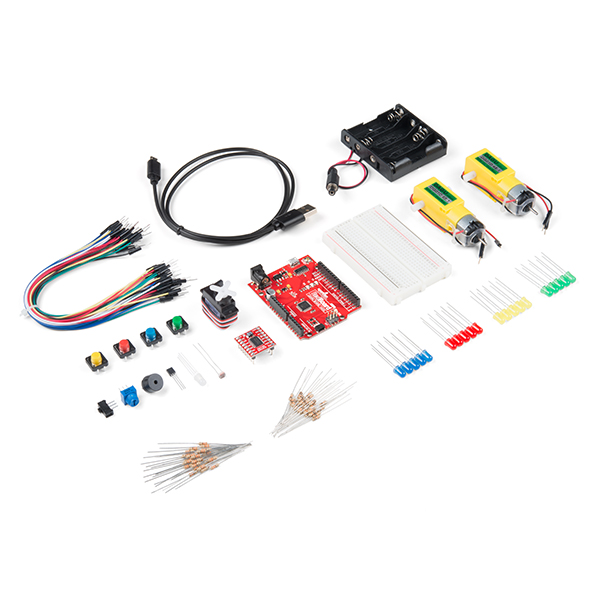SparkFun Tinker Kit
The SparkFun Tinker Kit (STK) is a great way to get started with programming and hardware interaction with the Arduino programming language. This latest version of the STK adds in the Qwiic functionality. Each SparkFun Tinker Kit includes everything you need to complete 11 circuits that will teach you how to blink an LED, read sensors, drive servos, and more. You don't need any previous programming or electronics experience to use this kit.
The online STK Experiment Guide (in the Documents section below) contains step-by-step instructions of how to connect each circuit with the included parts. Full example code is provided and explained, and even includes troubleshooting tips in case something goes wrong.
The kit does not require any soldering and is recommended for beginners ages 10 and up. This miniature version of the SIK will help prove that anyone can (and should) play around with cutting-edge electronics in a fun and playful way while not breaking the bank.
The SparkFun Qwiic Connect System is an ecosystem of I2C sensors, actuators, shields and cables that make prototyping faster and less prone to error. All Qwiic-enabled boards use a common 1mm pitch, 4-pin JST connector. This reduces the amount of required PCB space, and polarized connections mean you can’t hook it up wrong.
- SparkFun RedBoard Qwiic
- SparkFun Motor Driver (with Headers)
- Breadboard - Self-Adhesive (White)
- Servo -- Sub-Micro Size
- Hobby Gearmotor -- 200 RPM (Pair)
- Temperature Sensor -- TMP36
- Mini Photocell
- Pizeo Speaker
- Reversible USB A to Reversible Micro-B Cable - 0.8m
- Jumper Wires -- 7" M/M 30 AWG (30 Pack)
- LED - RGB Diffused Common Cathode
- Red, Blue, Yellow, and Green LEDs
- Red, Blue, Yellow, and Green Buttons
- Mini Power Switch
- 10K Trimpot
- Battery Holder - 4xAA to Barrel Jack Connector
- 330 and 10K Resistors
- Circuit 1: Blink an LED
- Circuit 2: Potentiometer
- Circuit 3: Photoresistor
- Circuit 4: RGB Night-Light
- Circuit 5: Buzzer
- Circuit 6: Digital Trumpet
- Circuit 7: Simon Says Game
- Circuit 8: Servo Motors
- Circuit 9: Temperature Sensor
- Circuit 10: Motor Basics
- Circuit 11: Driving a Motor w/ Inputs
SparkFun Tinker Kit Product Help and Resources
Tinker Kit Circuit Guide
September 16, 2021
This guide takes you through the basics of building 11 different circuits with the SparkFun Tinker Kit and how to program them using the Arduino IDE.
Core Skill: Robotics
This skill concerns mechanical and robotics knowledge. You may need to know how mechanical parts interact, how motors work, or how to use motor drivers and controllers.
Skill Level: Noob - You will be required to put together a robotics kit. Necessary parts are included and steps will be easy to follow. You also might encounter basic robotics components like bearings, mounts, or other hardware and need a general idea of how it goes together.
See all skill levels
Core Skill: Programming
If a board needs code or communicates somehow, you're going to need to know how to program or interface with it. The programming skill is all about communication and code.
Skill Level: Rookie - You will need a better fundamental understand of what code is, and how it works. You will be using beginner-level software and development tools like Arduino. You will be dealing directly with code, but numerous examples and libraries are available. Sensors or shields will communicate with serial or TTL.
See all skill levels
Core Skill: Electrical Prototyping
If it requires power, you need to know how much, what all the pins do, and how to hook it up. You may need to reference datasheets, schematics, and know the ins and outs of electronics.
Skill Level: Rookie - You may be required to know a bit more about the component, such as orientation, or how to hook it up, in addition to power requirements. You will need to understand polarized components.
See all skill levels
Comments
Looking for answers to technical questions?
We welcome your comments and suggestions below. However, if you are looking for solutions to technical questions please see our Technical Assistance page.
Customer Reviews
5 out of 5
Based on 2 ratings:
Everything I wanted
Well packaged, fast shipping to EU.
Great step up for my daughter
My 11 year old grew out of Snap Circuits and asked for something more challenging. She really wanted to start programming and also build more exciting projects that she could use in her costumes. Love the tutorials for this kit, especially the links to the history of breadboards and walk through of Ohm's Law. Should keep her curious for a long while.

